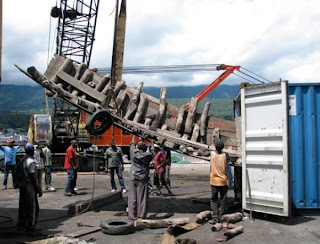... in the name of art?...
The comorians have used for many centuries the djahazi, an ancient wooden boat, as the only mean of transport to communicate and create commercial relations with their neighbors in the Mozambique channel. In modern times they used the traditional boats to transport the shipping containers from the cargo boats to the ports until their use was banned in 2006.
The comorians have used for many centuries the djahazi, an ancient wooden boat, as the only mean of transport to communicate and create commercial relations with their neighbors in the Mozambique channel. In modern times they used the traditional boats to transport the shipping containers from the cargo boats to the ports until their use was banned in 2006.
The djahazis were left to sink in the port of Moroni and most of the dockers were unemployed...
«Tamburella has fixed and restored one of the twenty eight boats forsaken at the port, with the help of workers from Moroni, but not as an antiquarian and nostalgic affectation. On the contrary, in Venice, this vessel, which will be loaded with a regular shipping container used in most of today’s trade, will stand as a metaphor for an ambivalent globality, bringing together hope and despair [...] emergence and emergency, in a sort of cautionary tale about the new forms of the expendable in a world of uncertainty and transition[...].» (Octavio Zaya, in the Biennale General Catalogue).
In the port of Moroni the djahazi boat was split in half and placed in a 40 feet container that travelled from Comoros to Marghera, an industrial district outside Venice.
Two
weeks before the opening of the Biennale the container, the artist
and the dockers will arrive in Venice. The Djahazi will be
reassembled, loaded with a shipping container as it was up to 2006,
to finally dock in the water area in front of the main entrance to
the Giardini for all the duration of the Biennale.












